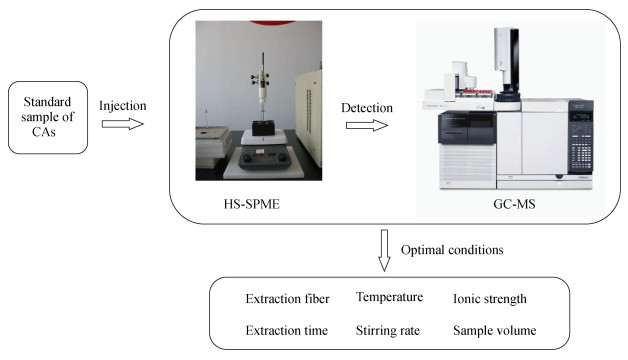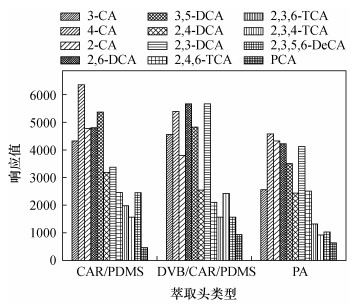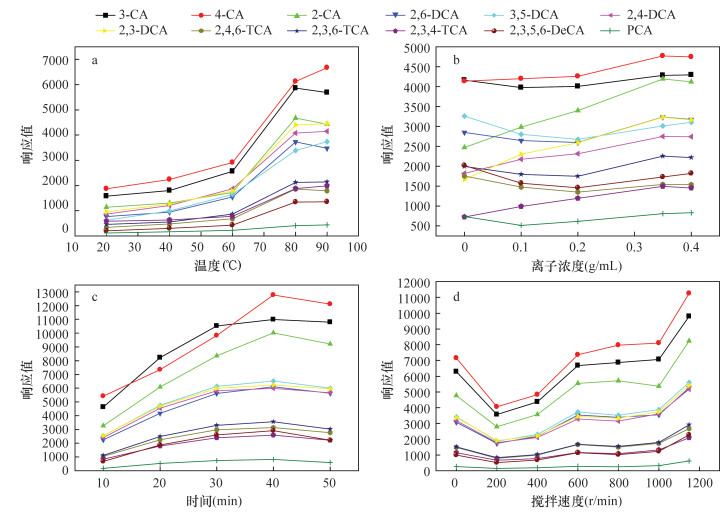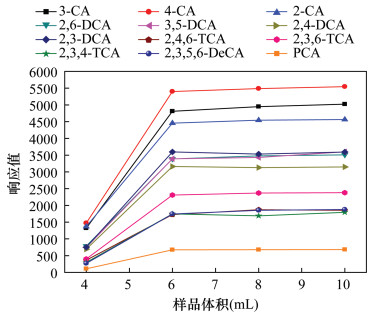Simultaneous Determination of 12 Chloroanisoles in Lake Reservoir Waters by Headspace Solid Phase Microextraction-Gas Chromatography-Mass Spectrometry
-
摘要: 氯苯甲醚类化合物(CAs)是地表水中普遍存在的嗅味物质,在世界各地水环境中均可发现CAs的存在,CAs易在食物链中富集和放大,且随着氯原子取代数增加其毒性逐渐增强。水体中CAs属于痕量物质,检测时需要先对其进行富集处理,以往研究大多是对单个物质进行检测。本文建立了采用顶空固相微萃取结合气相色谱-质谱联用技术同时测定湖库水中12种CAs的方法。对顶空固相微萃取过程中的萃取纤维、萃取温度、离子强度、萃取时间及搅拌速率等实验条件进行对比和优化,确认了最佳萃取条件为:萃取温度80℃,离子浓度0.35g/mL,萃取时间40min,搅拌速率1150r/min,样品体积10mL(15mL萃取瓶)。采用气相色谱-质谱选择性离子扫描方式进行定量分析,方法的线性范围为1~50ng/L,检出限为0.045~0.185ng/L,回收率为95.5%~115.1%,相对标准偏差≤ 13.02%。该方法相较于固相萃取及吹扫捕集法的检出限更低,对于样品浓度的变化感应度高,实验仪器的精密度优于其他方法。要点
(1) 对湖库水中12种CAs进行同时萃取和检测。
(2) 采用顶空固相微萃取法富集水体中CAs,给出了各因素的最佳萃取条件。
(3) GC-MS对CAs的检出限更低,检测结果更准确。
HIGHLIGHTS(1) 12 kinds of CAs in lake waters were extracted and detected simultaneously.
(2) The CAs in the waters were preconcentrated by headspace solid phase microextraction, and the optimal extraction conditions for each factor were given.
(3) GC-MS had lower detection limits for CAs and more accurate analytical results.
Abstract:BACKGROUNDChloroanisoles (CAs) are odorous substances and can easily be found in surface waters. The CAs have been found in water environments worldwide. In the food chain, CAs are easily enriched and amplified. The toxicity increases with the number of chlorine atoms substituted. CAs in waters are trace substances which need to be preconcentrated before determination. Previous studies focused on the detection of individual substances.OBJECTIVESTo establish a method which combines headspace solid phase microextraction and gas chromatography-mass spectrometry together, to simultaneously measure 12 CAs in waters.METHODSThe conditions of extraction fiber, temperature, ionic strength, extraction time and stirring rate were compared and optimized in headspace solid phase microextraction. The optimal extraction conditions were confirmed by the results. Extraction temperature was 80℃, ionic strength was 0.35g/mL, extraction time was 40 minutes, stirring rate was 1150r/min, and sample volume was 10mL (15mL extraction bottle).RESULTSQuantitative analysis was performed by gas chromatography-mass spectrometry with selective ion scanning. The linear ranges of the method were 1-50ng/L, and the recoveries were 95.5%-115.1%. The detection limits were 0.045-0.185ng/L and the relative standard deviation was less than 13.02%.CONCLUSIONSCompared with the solid phase extraction and the purge with trap method, this method has a lower detection limit and higher sensitivity of the sample concentration. Also, the precision of the experimental instrument is relatively better than other methods.
-
得益于海相页岩层系油气资源的钻完井和压裂技术革新,美国成为世界上最早实现页岩气商业化开采的国家, 其页岩气资源主要来自海相或海陆过渡相地层[1]。美国页岩气的成功商业化为中国页岩油气勘探开发关键技术探索提供了一定经验和借鉴[2]。我国广泛发育有海相、陆相和海陆过渡相三类富有机质页岩[3],页岩气可采资源量排名世界第二,其中陆相页岩气可采资源潜力为7.9×1012m3[4]。然而,与海相富有机质页岩相较,陆相页岩在沉积环境、干酪根类型、有机质成熟度和矿物组分等方面存在较大差异[5-7]。当前,我国海相页岩气储量评估方法与压裂技术基本达成共识,然而关于陆相页岩气(油)的研究在广度与深度上远远不足。鄂尔多斯盆地作为我国中新生代大型内陆坳陷沉积盆地,发育有石炭系、二叠系和三叠系等系列页岩沉积。其中三叠系延长组7段(C7)烃源岩埋藏浅,有机质丰度高,热演化程度低,具有良好的页岩气(油)成藏条件[8-9],有必要对其展开深入研究。
页岩孔隙结构是决定储层储集与运移能力的关键,对构建页岩气渗流模型[10]、完善压裂技术[11]具有重要意义。Loucks等[12]研究表明页岩中孔隙类型丰富,包括粒间孔、粒内孔、微裂缝和有机孔等,不同类型孔隙结构成因不同,对页岩气储集能力的贡献亦不相同。Wang等[13]证实页岩矿物基质与有机质分布模式在一定程度上控制和反映页岩的孔隙结构特征。王跃鹏等[14]提出延长组页岩中普遍发育的纹理结构会形成平行层理的孔缝结构,严重时造成井壁坍塌。前人工作表明,研究页岩孔隙结构有必要同时考虑有机质与矿物基质的空间分布特征。研究者围绕鄂尔多斯C7页岩孔隙结构已开展了大量研究工作,但是受测试方法的限制,对其微观结构的认识仍较为薄弱。吴银辉等[15]、杨维磊等[16]、庞铭等[7]、Jiang等[17]通过气体吸附实验、高压压汞实验和核磁共振实验对C7页岩孔隙结构特征展开研究,结果表明C7页岩中3~30nm的孔隙对总孔隙度贡献最大,为构建页岩孔隙模型提供了重要数据参考,但是上述成果对闭孔表征不足且缺乏对孔隙空间结构特征的直观认识。徐红卫等[18]采用扫描电镜对C7页岩孔隙结构特征展开研究,其研究成果表明C7页岩中主要发育纳米级狭缝型黏土矿物层间孔,然而其采用机械抛光制样对页岩表面孔隙结构造成了一定破坏,同时缺乏对页岩不同组分三维空间分布特征的认识。
目前,油气领域多采用氩离子抛光-扫描电镜方法对页岩孔隙结构进行直观观测[13, 19-20]。该方法有助于快速认识页岩孔隙类型、分布模式及孔径范围等,然而不足以提供精确数据用以构建页岩气三维渗流模型。对页岩三维结构的认识主要是利用微米X射线显微镜(micro X-ray microscope)[13, 21]、纳米X射线显微镜(nano-transmission X-ray microscope, TXM)[21-24]与聚焦离子束-扫描电子显微镜(focused ion beam-scanning electron microscope, FIB-SEM)[25-27]。与TXM和FIB-SEM方法相较,微米X射线显微镜方法的扫描范围大且成本较低,是研究陆相页岩纹理结构特征的重要技术手段。基于此,本文选取鄂尔多斯盆地南缘代表性C7页岩,采用氩离子抛光-扫描电镜与同步辐射微米X射线显微镜方法,对C7页岩的孔隙结构特征进行详细表征,探究陆相页岩孔隙结构特征影响因素,以期为完善陆相页岩气产能评估与压裂技术提供参考。
1. 实验部分
1.1 实验样品
C7页岩实验样品采自鄂尔多斯盆地遥科一(YK1)井。YK1井位于陕西省铜川市,构造位置属于鄂尔多斯盆地南缘渭北隆起构造单元(图 1)。长7油层组位于延长组中下部,代表湖盆最大扩张期。该时期随着盆地强烈沉陷,湖盆从长8期开始至长7期达到鼎盛时期,环绕湖盆退积型三角洲广泛发育并在开阔的浅湖-深湖区形成延长组的最主要的生油岩系[16]。岩心观测发现,C7页岩以黑色油页岩、凝灰岩与含油砂岩为主,夹杂碳酸盐岩薄层,如图 2所示。
X射线粉晶衍射测试表明,C7页岩样品中的石英与长石平均含量较高(分别为32%和24%),碳酸盐岩和黄铁矿含量相对较低,分别为9%和3%。脆性矿物平均含量大于50%,有利于天然裂隙和人工诱导裂缝的发育。黏土矿物含量为33%,几乎全部由伊蒙混层组成。伊蒙混层中伊利石含量为80%,主要为有序混层矿物(R=1型),表明延长组7段页岩处于成岩阶段中期[28]。实验样品有机碳平均含量为4.79%,属于富有机质页岩,其平均镜质体反射率为0.72%,对应有机质未成熟或低成熟阶段。
1.2 样品测试和数据分析方法
1.2.1 扫描电镜测试
选取新鲜页岩样品薄片(~1cm2),对其进行初步机械抛光后(2400目),放入离子减薄仪(LJB-1A,沈阳华业公司),利用氩离子束轰击预抛光的表面,得到品质较高的平面进行扫描电镜观察。制样过程中,氩离子减薄仪的工作电压为5kV,电流为100μA,抛光时间为10~12h[19, 25]。扫描电镜观测利用Merlin Compact LE0 1530 VP电镜(卡尔·蔡司公司)完成,矿物元素组成定性定量分析使用AZtec X-Max能谱仪(牛津仪器)进行。实验时扫描电镜加速电压为5kV,工作距离为4~6mm;能谱仪的工作电压为15kV,工作距离为8~10mm。
1.2.2 同步辐射X射线显微镜测试
利用砂纸将C7页岩样品打磨成圆柱形,直径大约5mm。微米X射线显微镜扫描实验在上海同步辐射装置X射线成像及生物医学应用光束线(BL13W1)[29]开展。X射线在磁场强度1.9T、磁周期14cm的十六极摆动器中激发,通过Si(111)双晶单色器进行单色化后穿过样品,然后被带有闪烁体的电荷耦合元件系统接收[11]。本文实验像素尺寸为3.25μm,能量为25keV, 样品到探头的距离为10cm。扫描过程中将样品的一端固定在旋转样品台上。整个实验中样品台共旋转180°,每隔0.2°采集一张投影图像。通过样品台的旋转,采集不同视角的投影图像,利用PITRE (phase-sensitive X-ray image processing and tomography recons-truction)软件进行图像重构[30]。首先,利用5张暗场图像与20张明场图像进行背景强度校正;其次,将采集的投影图像转换成正弦图像并进行归一化处理;最后,利用滤波反投影方法对正弦化图像进行重构[31]。
1.2.3 数据分析方法
微米X射线显微镜重构数据利用Avizo软件进行分析。首先,选择页岩代表性体积块1625μm × 1625μm × 1625μm,利用非局部均值滤波算法对所选CT图像进行平滑。其次,依据孔隙、有机质、碳酸盐岩和硅酸盐岩等对X射线的吸收系数差异, 采用阈值分割方法进行图像分割,实现延长7段页岩三维结构的重建与可视化。
2. 结果与讨论
2.1 孔隙二维结构特征
本文在参考Loucks等[12]页岩孔隙分类方案基础上,依据孔隙成因与其赋存特征将C7页岩气储集空间划分为无机孔、有机孔和微裂缝三类,如表 1所示。
表 1 遥科1井延长7段页岩孔隙类型及其特征Table 1. Pore types and characteristics of C7 Member shale from Yaoke-1 Well孔隙类型 孔隙示意图 孔隙形态 孔径范围 分布特征 无机孔 粒间孔 
三角形或狭缝形 30nm~1μm 发育在脆性矿物周缘及粉砂级黏土矿物碎屑之间,普遍发育,连通性较好 黏土矿物层间孔 
平直狭缝状 长1~3μm,孔宽数十纳米 分布于黏土矿物层间,不甚发育 溶蚀孔 
凹坑状 50~300nm 多见于石英、长石等矿物内部,彼此孤立 晶内孔、生物孔、晶间孔等 
圆形、椭圆形或方形等 百纳米~数十微米 与矿物相关,如生物遗体被黄铁矿充填,彼此孤立; 或形成于矿物晶间 有机质与有机孔 致密有机质 
连续且不规则状 N/A 有机质最主要的赋存方式,即粒间孔被有机质完全充填,且有机质内部无孔隙发育 
集合体形式 N/A 与黄铁矿呈现出包裹关系,与微晶之间残余少许孔缝 
有机质分散状,发育锯齿状孔隙 数百纳米至数微米 致密有机质与基质矿物接触面之间发育孔隙,较为普遍 有机孔 
狭缝状、三角状 50~300nm 受控于黏土矿物层间孔结构,有机孔最主要的存在形式 
凹坑状或椭圆状 30~200nm 受生烃作用控制,发育较少 微裂缝 
狭缝状 长数微米,宽几百纳米 发育于脆性矿物的边缘或机械不稳定部位,较平直,延伸长 注:N/A表示not applicable(不适用)。 2.1.1 无机孔和微裂缝结构特征
C7页岩中无机孔广泛发育,包括粒间孔、黏土矿物层间孔和溶蚀孔等。粒间孔主要发育在脆性矿物周缘和黏土碎屑之间。脆性矿物周缘孔以狭缝形为主,孔长约1μm,孔宽约100nm (图 3a),在C7页岩中普遍发育;粉砂级黏土岩屑彼此连接,形成原生粒间孔,是C7页岩中发育最多的孔隙类型,以三角形为主,孔径集中于30~250nm,连通性较好(图 3b)。黏土矿物层间孔发育在黏土矿物层间,以平直狭缝状为主,孔长1~3μm,孔宽数十纳米(图 3c),发育较少。溶蚀孔是烃源岩生烃过程中产生大量有机酸将矿物溶解所形成的次生孔隙。C7页岩中溶蚀孔数量较少且孤立存在,以凹坑状为主,孔径50~300nm(图 3d)。
C7页岩中同时发育黄铁矿晶内孔和锐钛矿晶间孔等特殊的孔隙类型。黄铁矿晶内孔见图 3e。能谱图(图 3f)表明图 3e中十字标记区域元素组成主要为Fe、S、O、Si。该类孔隙基本呈圆形,黄铁矿质孔隙壁厚3~5μm,孔径数十微米,孔隙部分或全部被矿物碎屑或有机质充填,彼此之间并无连通性。锐钛矿晶间孔如图 3h和图 3i所示,孔径集中于数百纳米,连通性较好。此前在海相沉积威远九老洞组页岩[19]、辽河凹陷沙河街组页岩[32]中均观测到该类型孔隙,表明锐钛矿晶间孔的主要形成机理并非受控于沉积环境。C7页岩中亦发育少许生物孔,如图 3g所示,孔径30~50nm,推测为生物遗体被矿物质充填所形成。
微裂缝在C7页岩中较为发育,以构造裂缝为主。构造裂缝一般沿机械不稳定面发育,如脆性矿物与片状黏土矿物的外部或颗粒之间(图 3j,3k),或沿黏土矿物层理发育(图 3l),较平直,延伸尺度较大,长数微米,宽度几百纳米。普遍发育的微裂缝是沟通各类微观孔隙的桥梁,为页岩气运移提供了重要的渗流通道。
2.1.2 有机质与有机孔发育特征
C7页岩中有机孔发育较少,依据发育形态和成因可分成两类。第一类有机孔发育在离散状有机质内部,其形成受控于有机质生烃作用,发育极少,呈椭圆状或凹坑状(图 4a)等,孔径30~200nm。另外一类有机孔与有机黏土矿物共生,是C7页岩中有机孔最主要的存在形式。该类有机孔具有继承性结构,受黏土矿物层间孔的形貌控制,以狭缝状或层状为主,如图 4b和4c所示。黏土矿物强烈的吸附能力促使有机质在烃源岩中富集,与黏土矿物以结合态存在。在有机质生烃过程中,黏土矿物降低了生烃反应活化能,同时为其提供了电子(OH-)和质子(H+)来源。类似结构在四川盆地页岩气勘探有利储层龙马溪组海相页岩中发现较多[6],不仅佐证了黏土矿物的催化生烃作用,而且说明陆相页岩有机孔的形成机理与海相页岩具有一定相似性。
C7页岩中存在大量致密有机质,大小数百纳米至数微米,形态复杂,主要受控于无机孔缝的形状。图 4d中有机质彼此连接,填充于不规则状矿物碎屑粒间孔中,与粒间孔边缘完全接触;图 4e中条带状有机质充填于粒间孔中,彼此孤立存在,单个有机质长达数十微米;图 4f中条带状有机质则充填于黏土矿物层间,取向与黏土矿物一致,宽50~200nm。部分有机质与黄铁矿共生,表现为包裹关系,如图 4g所示,黄铁矿晶间孔几乎完全被有机质充填,仅在有机质与微晶之间残余少许孔缝。致密有机质与矿物基质接触面之间发育部分孔隙,该类孔隙往往与有机质取向一致,呈锯齿状、平直状和三角状等,孔径集中于数微米,如图 4h和图 4i所示。
2.2 页岩三维结构特征
C7页岩微米X射线重构图像如图 5a所示。图像中灰度值由白(255)到黑(0)代表物质的密度由大到小。结合扫描电镜数据判断,白色部分主要为黄铁矿,灰白色部分主要是钙质或铝铁质矿物;黑色部分代表低密度物质,理论上包括微孔隙、微裂缝和有机质。以下将低密度物质界定为有机质,主要原因如下:扫描电镜观测证实C7页岩中主要发育纳米孔,本文微米X射线扫描实验(分辨率3.25μm)不足以识别;从重构图像中可以看出,低密度物质大小集中于亚微米至微米,主要呈带状或星点状等,与扫描电镜下有机质的形貌大小一致;剖面线(图 5b)经过低密度物质时,灰度值均在90左右(孔隙灰度值接近0)。
经过物相分割,通过三维数值模拟得到C7页岩三维结构,如图 6所示。有机质、钙质(包括铝铁质)矿物和黄铁矿分别以红色,绿色以及黄色标记,空白区域代表硅铝质矿物(石英和长石等)。图 6表明C7页岩中,有机质与钙质、铝铁质矿物排列有序,在微米尺度上具有明显的纹层结构,黄铁矿则以无序状分散在矿物基质中。
图 6b展示了C7页岩有机质三维空间分布特征。有机质体积含量为3.4%,整体呈纹层结构。大部分有机质体积较小,均匀地分散于矿物基质中;少数有机质体积较大,取向与纹层一致,如图 7a所示。图 7a是图 6b中部分有机质的放大图,从图中能够看出该有机质颗粒长约700μm,宽约80μm,呈不完全连续分布。钙质和铝铁质矿物的三维空间结构如图 6c所示,其体积百分数达7.5%,同样具有纹层结构,取向与有机质分布模式一致。与有机质的均匀分布不同,钙质与铝铁质矿物在某些纹层内出现富集。此外,少量铝铁质矿物呈球状,体积较大, 如图 7b所示,随机分布于矿物基质中。黄铁矿体积含量较低,约0.7%,在三维空间中随机分布,如图 6d所示。黄铁矿颗粒大小集中于10~20μm,相对均匀地分散于矿物基质中;少数黄铁矿聚集在一起,形成团块儿状集合体。部分黄铁矿可能充填于生物遗体中,其三维结构放大图如图 7c所示。从图中可以看出,该类孔呈不封闭的球状,孔径约45μm。
2.3 孔隙结构特征与其控制因素
扫描电镜观测结果表明C7页岩中无机孔和微裂缝最为发育。无机孔以发育在黏土碎屑颗粒之间的原生粒间孔为主,黏土矿物层间孔和脆性矿物周缘孔等海相页岩中普遍发育的孔隙类型发现较少。一方面,页岩中大量存在的碎屑状黏土矿物为孔隙发育提供了物质基础,是控制主要孔隙类型发育的重要因素之一;另一方面受成岩作用控制,原生层间孔和脆性矿物周缘孔难以保存[33]。与四川盆地广泛发育的海相页岩相较,C7页岩中有机孔鲜有发育[5-7]。有机孔的形成、形貌及大小主要与有机质含量、类型和热成熟度密切相关。鄂尔多斯盆地三叠系C7页岩热演化程度较低,大部分处于低成熟阶段,因此不具备大量发育有机孔的条件。有机质主要呈致密态,不均匀地充填于无机孔与微裂缝中,在一定程度上进一步降低了孔隙度。
扫描电镜测试表明C7页岩中介孔数量占绝对优势,对孔隙体积贡献最大,提供了主要的储集空间。黏土矿物颗粒细小,分选好,是介孔大量发育的关键因素。鄂尔多斯盆地长7期深湖细粒沉积背景导致原始的粒间孔隙相对较小[34-35];强烈的压实作用使颗粒间紧密接触,同时胶结作用使大的粒间孔隙消失,残留了小尺度的粒间孔隙[36]。C7页岩中亦发育少量宏孔,孔径主体数百纳米,主要以粒间孔和微裂缝形态存在。脆性矿物含量较高是宏孔发育的重要原因。但是细粒黏土矿物与有机质的充填作用,在一定程度上导致宏孔数量降低。
2.4 对页岩气运移和压裂的启示
本文利用微米X射线显微镜证实C7页岩在微米尺度上具有明显的纹层结构,有机质纹层发育且连续性强,表明C7页岩具有较强塑性。李丽慧等[37]通过三轴压裂实验证实该类结构中,压裂缝以沿纹层扩展为主且易再次闭合,从而降低了储层的可压裂性。不过,随着有机质成熟度的增加,该结构沿层理方向易于形成相互连接的孔隙网络,从而有利于页岩气的横向运移[38]。扫描电镜测试表明各纹层中的微米级微构造裂缝发育较多,王跃鹏等[14]认为该类裂缝可能是由于水进入页岩内部发生水化作用,导致黏土矿物沉淀而形成的。该结构意味着水力压裂开采技术容易破坏C7页岩结构的完整性,引发井壁坍塌等严重问题。
3. 结论
本文利用氩离子抛光-扫描电镜和微米X射线显微镜方法,对鄂尔多斯陆相延长7段页岩孔隙结构特征进行研究。测试结果表明:①受黏土碎屑和成岩作用控制,延长7段页岩中主要发育纳米级粒间孔与微米级微裂缝,是页岩气的主要储运空间。有机质主要呈致密状,有机孔发育较少,一般与有机黏土矿物共存。②延长7段页岩在微米尺度上具有明显的纹层结构,有机质纹层发育且连续性强,不利于储层压裂。同时,大量存在的黏土矿物与微裂缝在水力压裂时容易引发井壁坍塌等严重问题。
微米X射线显微镜技术是深入研究陆相页岩纹层三维结构特征的有效方法,与氩离子抛光-扫描电镜技术结合,有利于实现页岩孔隙结构特征的多尺度多维度综合表征。本文研究成果可为后期页岩气水平井结构设计、提高井壁稳定性提供改进思路。
-
表 1 氯苯甲醚的线性关系和方法检出限
Table 1 Linear relationship and detection limits of CAs
目标分析物 保留时间(min) 特征离子 线性范围
(ng/L)相关系数
(R2)方法检出限
(ng/L)3-CA 10.370 142.0 98.9 111.9 1~50 0.9990 0.120 4-CA 10.691 142.0 98.9 111.9 1~50 0.9978 0.125 2-CA 11.051 142.0 127.0 126.9 1~50 0.9991 0.129 2, 6-DCA 13.240 176.0 134.8 177.9 1~50 0.9990 0.074 3, 5-DCA 14.629 176.0 134.8 177.9 1~50 0.9992 0.068 2, 4-DCA 15.682 176.0 134.8 177.9 1~50 0.9991 0.064 2, 3-DCA 16.532 176.0 134.8 177.9 1~50 0.9987 0.057 2, 4, 6-TCA 16.775 210.0 168.8 211.8 1~50 0.9989 0.185 2, 3, 6-TCA 17.907 211.8 211.8 211.8 1~50 0.9997 0.132 2, 3, 4-TCA 21.212 211.8 211.8 211.8 1~50 0.9982 0.106 2, 3, 5, 6-TeCA 21.618 202.8 230.8 245.9 1~50 0.9999 0.086 PCA 26.009 264.6 277.6 281.8 1~50 0.9980 0.045 表 2 氯苯甲醚的回收率及相对标准偏差
Table 2 Recoveries and relative standard deviations of CAs
目标分析物 加标浓度
(ng/L)检出浓值
(ng/L)平均回收率
(%)RSD
(%)3-CA 10 10.77 107.7 10.73 50 50.51 101.0 0.46 4-CA 10 11.51 115.1 7.56 50 47.82 95.6 4.13 2-CA 10 9.55 95.5 8.96 50 48.91 97.8 3.26 2, 6-DCA 10 10.09 100.9 13.02 50 49.93 99.9 0.51 3, 5-DCA 10 10.38 103.8 7.90 50 50.77 101.5 1.92 2, 4-DCA 10 10.30 103.0 9.51 50 49.12 98.2 3.04 2, 3-DCA 10 10.24 102.4 9.26 50 49.91 99.8 0.46 2, 4, 6-TCA 10 10.35 103.5 8.27 50 50.08 100.1 0.29 2, 3, 6-TCA 10 10.55 105.5 7.11 50 49.99 100.0 0.46 2, 3, 4-TCA 10 10.37 103.7 1.57 50 56.90 113.8 0.67 2, 3, 5, 6-TeCA 10 9.93 99.3 11.25 50 49.36 98.7 0.25 PCA 10 10.14 101.4 2.57 50 56.17 112.3 1.87 -
Fischer C, Fischer U.Analysis of cork taint in wine and cork material at olfactory subthreshold levels by solid phase microextraction[J].Journal of Agricultural & Food Chemistry, 1997, 45(6):1995-1997. http://www.wanfangdata.com.cn/details/detail.do?_type=perio&id=631809a2779c82b1e3a64740dc227cb2
Polásková P, Herszage J, Ebeler S E.Wine flavor:Che-mistry in a glass[J].Chemical Society Reviews, 2008, 37(11):2478-2489. doi: 10.1039/b714455p
Ribéreau-Gayon P, Glories Y, Maujean A, et al.Hand-book of Enology:The Chemistry of Wine Stabilization and Treatments[M].New Jersey:John Wiley & Sons, 2006.
Yu S, Xiao Q, Zhu B, et al.Gas chromatography-mass spectrometry determination of earthy-musty odorous compounds in waters by two phase hollow-fiber liquid-phase microextraction using polyvinylidene fluoride fibers[J].Journal of Chromatography A, 2014, 1329(3):45-51. http://www.wanfangdata.com.cn/details/detail.do?_type=perio&id=d88b50cec2614bdff99fd8ce3ffefb78
Nystrom A, Grimvall A, Krantzrulcker C, et al.Drinking-water off-flavor caused by 2, 4, 6-trichloroanisole[J].Water Science and Technology, 1992, 25(2):241-249. doi: 10.2166/wst.1992.0058
毛敏敏, 张可佳, 张土乔, 等.大体积浓缩-固相微萃取-气相色谱-质谱联用测定水样中6种典型嗅味物质[J].分析化学, 2013, 41(5):760-765. http://d.old.wanfangdata.com.cn/Periodical/fxhx201305023 Mao M M, Zhang K J, Zhang S Q, et al.Determination of six typical taste and odor compounds using large volume voncentration, solid phase micro-extraction and gas chromatography-mass spectrometry[J].Chinese Journal of Analytical Chemistry, 2013, 41(5):760-765. http://d.old.wanfangdata.com.cn/Periodical/fxhx201305023
Pizarro C, Pérez-del-Notario N, Sáenz-Mateo A, et al.A simple and sensitive vortex assisted liquid-liquid microextraction method for the simultaneous determination of haloanisoles and halophenols in wines[J].Talanta, 2014, 128:1-8. doi: 10.1016/j.talanta.2014.04.005
Prescott J, Norris L, Kunst M, et al.Estimating a "consumer rejection threshold" for cork taint in white wine[J]. Food Quality and Preference, 2005, 16(4):345-349. doi: 10.1016/j.foodqual.2004.05.010
任敏, 赵高峰, 王晓燕, 等.环境中氯苯甲醚类污染物研究进展[J].环境工程技术学报, 2017, 7(3):357-365. doi: 10.3969/j.issn.1674-991X.2017.03.050 Ren M, Zhao G F, Wang X Y, et al.Research progress of chloroanisoles pollutants in the environment[J].Journal of Environmental Engineering Technology, 2017, 7(3):357-365. doi: 10.3969/j.issn.1674-991X.2017.03.050
Lu X, Fan C, Shang J, et al.Headspace solid-phase microextraction for the determination of volatile sulfur compounds in odorous hyper-eutrophic freshwater lakes using gas chromatography with flame photometric detection[J].Microchemical Journal, 2012, 104:26-32. doi: 10.1016/j.microc.2012.04.001
Cheng Y, Ekker M, Chan H M.Relative developmental toxicities of pentachloroanisole and pentachlorophenol in a zebrafish model (Danio Rerio)[J].Ecotoxicology & Environmental Safety, 2015, 112:7-14. http://www.wanfangdata.com.cn/details/detail.do?_type=perio&id=0495f025b48a78cbca61c8e30f0784e1
International Standard Organization.Cork Stoppers-Determination of Releasable 2, 4, 6-Trichloroanisole (TCA): ISO 20752-2007[S].Switzerland: ISO Copyright Office, 2007.
孙静, 王锐, 尹大强.顶空固相微萃取-气质联用法同时测定城市水源水中的九种嗅味物质[J].环境化学, 2016, 35(2):280-286. http://d.old.wanfangdata.com.cn/Periodical/hjhx201602007 Sun J, Wang R, Yin D Q.Simultaneous determination of nine taste and odor compounds in source water of Chinese cities by headspace solid phase micro-extraction combined with gas chromatography-mass spectrometry[J].Environmental Chemistry, 2016, 35(2):280-286. http://d.old.wanfangdata.com.cn/Periodical/hjhx201602007
Bellar T A, Lichtenberg J J, Kroner R C.The occurrence of organohalides in chlorinated drinking waters[J].Journal American Water Works Association, 1974, 66(12):703-706. doi: 10.1002/j.1551-8833.1974.tb02129.x
王园园, 宋晓明, 温玉娟, 等.固相萃取-衍生化-气相色谱-质谱联用测定不同水体中类固醇雌激素方法研究[J].岩矿测试, 2017, 36(5):519-528. doi: 10.15898/j.cnki.11-2131/td.201705310092 Wang Y Y, Song X M, Wen Y J, et al.Determination of steroid estrogens in different water samples using SPE-derivatization coupled with GC-MS[J].Rock and Mineral Analysis, 2017, 36(5):519-528. doi: 10.15898/j.cnki.11-2131/td.201705310092
Arthur C L, Pawliszyn J.Solid phase microextraction with thermal desorption using fused silica optical fibers[J].Analytical Chemistry, 1990, 62(19):2145-2148. doi: 10.1021/ac00218a019
王丹华, 邢钧, 吴采樱.用自制新型端羟基冠醚固相微萃取涂层快速监测水中痕量多环芳烃[J].分析科学学报, 2003, 19(2):109-112. doi: 10.3969/j.issn.1006-6144.2003.02.003 Wang D H, Xing J, Wu C Y.Application of the novel benzon-15-crown-5 sol-gel coating for solid-phase microextraction in rapid determination of trace PAHs in water at nonequilibrium situatins[J].Journal of Analytical Science, 2003, 19(2):109-112. doi: 10.3969/j.issn.1006-6144.2003.02.003
Kristiana I, Joll C, Heitz A.Analysis of halonitriles in drinking water using solid-phase microextraction and gas chromatography-mass spectrometry[J].Journal of Chromatography A, 2012, 1225(1):45-54. http://www.wanfangdata.com.cn/details/detail.do?_type=perio&id=f1918d3fd5599328b48ec4014dfab6c2
余胜兵, 朱炳辉, 许瑛华, 等.顶空固相微萃取谱-气相色谱-质谱联用测定饮用水中6种致嗅化合物[J].分析试验室, 2013, 32(7):58-62. http://www.wanfangdata.com.cn/details/detail.do?_type=perio&id=fxsys201307013 Yu S B, Zhu B H, Xu Y H, et al.Determination of six earthy musty odorous compounds in drinking water by headspace solid-phase microextraction coupled with gas chromatography-mass spectroscopy[J].Chinese Journal of Analysis Laboratory, 2013, 32(7):58-62. http://www.wanfangdata.com.cn/details/detail.do?_type=perio&id=fxsys201307013
Vestner J, Fritsch S, Rauhut D.Development of a microwave assisted extraction method for the analysis of 2, 4, 6-trichloroanisole in cork stoppers by SIDA-SBSE-GC-MS[J].Analytica Chimica Acta, 2010, 660(1):76-80.
Pizarro C C, Sáenz-González N, Pérez-del-Notario, et al.Development of a dispersive liquid-liquid microextraction method for the simultaneous determination of the main compounds causing cork taint and brett character in wines using gas chromatography-tandem mass spectrometry[J].Journal of Chromato-graphy A, 2011, 1218(12):1576-1584. doi: 10.1016/j.chroma.2011.01.055
Martínez-Uruñuela A, González-Sáiz J M, Pizarro C.Optimisation of a headspace solid-phase microextraction method for the direct determination of chloroanisoles related to cork taint in red wine[J].Journal of Chromatography A, 2004, 1056(1):49-56. http://www.wanfangdata.com.cn/details/detail.do?_type=perio&id=956dc2426d2f01a47530c48628baa8d3
Pizarro C, Pérez-del-Notario N, González-Sáiz J M.Multiple headspace solid-phase microextraction for eliminating matrix effect in the simultaneous determination of haloanisoles and volatile phenols in wines[J].Journal of Chromatography A, 2007, 1166(1):1-8. http://www.wanfangdata.com.cn/details/detail.do?_type=perio&id=08b2e3584b2c80fe877f83cbbb40bb04
Yu S, Qin X, Zhu B, et al.Gas chromatography-mass spectrometry determination of earthy-musty odorous compounds in waters by two phase hollow-fiber liquid-phase microextraction using polyvinylidene fluoride fibers[J].Journal of Chromatography A, 2014, 1329(3):45-51. http://www.wanfangdata.com.cn/details/detail.do?_type=perio&id=d88b50cec2614bdff99fd8ce3ffefb78
Apostolou T, Pascual N, Marco M, et al.Extraction-less, rapid assay for the direct detection of 2, 4, 6-trichloroanisole (TCA) in cork samples[J].Talanta, 2014, 125:336-340. doi: 10.1016/j.talanta.2014.03.023
Chen X, Luo Q, Yuan S, et al.Simultaneous determina-tion of ten taste and odor compounds in drinking water by solid-phase microextraction combined with gas chromatography-mass spectrometry[J].Journal of Environmetal Sciences, 2013, 25(11):2313-2323. doi: 10.1016/S1001-0742(12)60290-3
高松, 邓银舟, 李玉芹, 等.闭合超声循环吹扫针捕集动态提取-气相色谱法测定地下水中的4种有机磷农药[J].岩矿测试, 2015, 34(4):480-486. doi: 10.15898/j.cnki.11-2131/td.2015.04.017 Gao S, Deng Y Z, Li Y Q, et al.Determination of organophosphorus pesticides in groundwater by gas chromatography coupled with closed ultrasound circulating purge needle trap[J].Rock and Mineral Analysis, 2015, 34(4):480-486. doi: 10.15898/j.cnki.11-2131/td.2015.04.017
徐洁, 鲜啟鸣.气相色谱-质谱法分析某阻燃剂生产厂周边淡水鱼中的多溴联苯醚及其累积特征[J].岩矿测试, 2017, 36(4):405-412. doi: 10.15898/j.cnki.11-2131/td.201702200017 Xu J, Xian Q M.Determination of polybrominated diphenyl ethers and bioaccumulation in freshwater fish surrounding a flame retardant manufacturing plant by gas chromatography-mass spectrometry[J].Rock and Mineral Analysis, 2017, 36(4):405-412. doi: 10.15898/j.cnki.11-2131/td.201702200017
Giansante L, di Vincenzo D, Bianchi G.Classification of monovarietal Italian olive oils by unsupervised (PCA) and supervised (LDA) chemometrics[J].Journal of Science of Food and Agriculture, 2003, 83(9):905-911. doi: 10.1002/jsfa.1426
Camino-Sánchez F J, Ruiz-García J, Zafra-Gómez A.Development of a thermal desorption gas chromatography-mass spectrometry method for quantitative determination of haloanisoles and halophenols in wineries' ambient air[J].Journal of Chromatography A, 2013, 13(5):259-266. http://www.wanfangdata.com.cn/details/detail.do?_type=perio&id=55a3b785c65f1d279db4de9d77e39e2b
吴采樱.固相微萃取[M].北京:化学工业出版社, 2012:85-107. Wu C Y.Solid Phase Microextraction[M].Beijing:Chemical Industry Press, 2012:85-107.
魏魏, 郭庆园, 赵云云, 等.顶空固相微萃取-气质联用法测定水中7种致嗅物质[J].中国给水排水, 2014, 30(18):131-135. http://www.wanfangdata.com.cn/details/detail.do?_type=perio&id=zgjsps201418034 Wei W, Guo Q Y, Zhao Y Y, et al.Simultaneous determination of seven fishy aldehydes in water samples using headspace solid-phase microextraction coupled with gas chromatography/mass spectrometry[J].China Water and Wastewater, 2014, 30(18):131-135. http://www.wanfangdata.com.cn/details/detail.do?_type=perio&id=zgjsps201418034
张哲琦, 牟德华, 李艳.优化GC检测2, 4, 6-三氯苯甲醚的萃取条件[J].食品工业科技, 2014, 35(24):89-95. http://d.old.wanfangdata.com.cn/Periodical/spgykj201424023 Zhang Z Q, Mou D H, Li Y.Optimization of extraction conditions of 2, 4, 6-trichloroanisole determination by gas chromatography[J].Science and Technology of Food Industry, 2014, 35(24):89-95. http://d.old.wanfangdata.com.cn/Periodical/spgykj201424023
徐振秋, 张晓赟, 徐恒省.顶空固相微萃取-气相色谱-质谱法测定饮用水中9种嗅味物质[J].化学分析计量, 2017, 26(2):48-51. doi: 10.3969/j.issn.1008-6145.2017.02.013 Xu Z Q, Zhang X Z, Xu H S.Detection of nine odor compounds in drinking water by headspace solid phase micro-extraction coupled with gas chromatography-mass spectrometry[J].Chemistry Analysis and Meterage, 2017, 26(2):48-51. doi: 10.3969/j.issn.1008-6145.2017.02.013
Buchholz K D, Pawliszyn J.Optimization of solid-phase microextraction conditions for determination of phenols[J].Analytical Chemistry, 1994, 66(1):160-167. doi: 10.1021/ac00073a027
Zalacain A, Alonso G L, Lorenzo C, et al.Stir bar sorptive extraction for the analysis of wine cork taint[J].Journal of Chromatography A, 2004, 1033(1):173-178. doi: 10.1016/j.chroma.2003.12.059
宋荣娜, 杨晓芳, 吕明晗, 等.HS-SPME-GC/MS同时测定污废水中多种VOCs异味物质[J].环境化学, 2019, 38(5):1047-1056. http://www.cnki.com.cn/Article/CJFDTotal-HJHX201905011.htm Song R N, Yang X F, Lü M H, et al.Simultaneous determination of various odorous VOC substances in sewage wastewater by HSSPME-GC/MS[J].Environmental Chemistry, 2019, 38(5):1047-1056. http://www.cnki.com.cn/Article/CJFDTotal-HJHX201905011.htm
陈臣, 李艳, 牟德华.优化GC检测欧李酒香气成分的萃取条件[J].食品工业科技, 2014, 35(6):81-86. http://d.old.wanfangdata.com.cn/Periodical/spgykj201406018 Chen C, Li Y, Mou D H.Optimization extraction conditions for GC analysis of aromatic constituents in prunus humilis bunge wine[J].Science and Technology of Food Industry, 2014, 35(6):81-86. http://d.old.wanfangdata.com.cn/Periodical/spgykj201406018
范苓, 秦宏兵, 张晓赟.顶空固相微萃取-气相色谱/质谱法同时测定富营养化水体中9种异味物质[J].江南大学学报(自然科学版), 2014, 13(3):355-359. doi: 10.3969/j.issn.1671-7147.2014.03.019 Fan L, Qin H B, Zhang X Z.Determination of nine off-flavor compounds in water by gas chromatography-mas spectrometry with headspace solid phase micro-extraction[J].Journal of Jiangnan University (Natural Science Edition), 2014, 13(3):355-359. doi: 10.3969/j.issn.1671-7147.2014.03.019
马康, 张金娜, 何雅娟, 等.顶空固相微萃取-气质联用测定环境水样中7种痕量土霉味物质[J].分析化学, 2011, 39(12):1823-1829. http://www.cqvip.com/QK/93919X/201112/40204192.html Ma K, Zhang J N, He Y J, et al.Determination of seven musty odor compounds in water by gas chromatography mass spectrometry with headspace solid phase micro-extraction[J].Chinese Journal of Analytical Chemistry, 2011, 39(12):1823-1829. http://www.cqvip.com/QK/93919X/201112/40204192.html
Whitfield F B, Hill J L, Shaw K J.2, 4, 6-tribromoani-sole:A potential cause of mustiness in packaged food[J].Journal of Agricultural and Food Chemistry, 1997, 45(3):889-893. doi: 10.1021/jf960587u
赵英莲, 牟德华, 李艳, 等.顶空固相微萃取联合气相色谱-质谱检测葡萄酒中2, 4, 6-三氯苯甲醚[J].食品科学, 2016, 37(10):219-225. doi: 10.7506/spkx1002-6630-201610038 Zhao Y L, Mou D H, Li Y, et al.Optimization of headspace solid-phase microextraction coupled to gas chromatography-mass spectrometry for the determination of 2, 4, 6-trichloroanisole in wine[J].Food Science, 2016, 37(10):219-225. doi: 10.7506/spkx1002-6630-201610038
齐美玲.气相色谱分析及应用[M].北京:科学出版社, 2012. Qi M L.Gas Chromatography Analysis and Application[M].Beijing:Science Press, 2012.
沈斐, 苏晓燕, 许燕娟, 等.吹扫捕集-GC/MS法测定饮用水中致嗅物质[J].环境监测管理与技术, 2010, 22(5):31-35. doi: 10.3969/j.issn.1006-2009.2010.05.008 Shen F, Su X Y, Xu Y J, et al.Determination of odor materials in drinking water by GC/MS with purge and trap[J].The Administration and Technique of Environmental Monitoring, 2010, 22(5):31-35. doi: 10.3969/j.issn.1006-2009.2010.05.008
唐熙, 梁鸣, 李小晶, 等.气相色谱-质谱法测定软木塞中2种霉味物质[J].色谱, 2012, 30(7):733-737. http://d.old.wanfangdata.com.cn/Periodical/sp201207015 Tang X, Liang M, Li X J, et al.Determination of two mouldy compounds in cork by gas chromatography-mass spectrometry[J].Chinese Journal of Chromatography, 2012, 30(7):733-737. http://d.old.wanfangdata.com.cn/Periodical/sp201207015
-
期刊类型引用(8)
1. 王小花,黄韡,顾培良,李静,周佳. 基于自动顶空-固相微萃取-气相色谱质谱检测葡萄酒中的9种木塞污染物. 食品科技. 2024(08): 322-328 .  百度学术
百度学术
2. 吴悦,赖永忠,陆国永,林晓昇,梁树生,许文帅. 顶空/气相色谱-质谱法同时测定印染废水中吡啶、苯胺和硝基苯. 岩矿测试. 2023(04): 781-792 .  本站查看
本站查看
3. 陶慧,黄理金,欧阳磊,帅琴. 氨基化共价有机骨架固相微萃取涂层用于水体中酚类的高效萃取. 岩矿测试. 2022(06): 1040-1049 .  本站查看
本站查看
4. 黄百祺,沈丹妮,王如意,李双林,林焕怡,李咏梅. 不同萃取头分析大高良姜挥发性成分效果比较. 中成药. 2021(06): 1656-1662 .  百度学术
百度学术
5. 赵佳平,王俊霞,刘婷婷,张占恩. 含铁二氧化硅涂层固相微萃取-GC/MS法测定水中的有机磷阻燃剂. 现代化工. 2021(09): 235-240 .  百度学术
百度学术
6. 梁淼,杨艳,石嘉悦,汪兴平,郑福平,余爱农. 酶/酸水解毛叶木姜子中键合态香味成分的比较. 精细化工. 2020(05): 989-996 .  百度学术
百度学术
7. 孙书堂,严倩,黎宁,黄理金,帅琴. 铁丝原位自转化-固相微萃取新涂层应用于萃取环境水样中多环芳烃的性能研究. 岩矿测试. 2020(03): 408-416 .  本站查看
本站查看
8. 杨洪早,李锦宇,王东升,张世栋,董书伟,闫宝琪,那立冬,吴春丽,邓俊,吴冠连,陈新丽,赵留涛,朱凯,梁永喜,严作廷. GC法测定马香苓口服液中百秋李醇含量研究. 中国畜牧兽医. 2020(07): 2264-2276 .  百度学术
百度学术
其他类型引用(3)




 下载:
下载:









 京公网安备 11010202008159号
京公网安备 11010202008159号